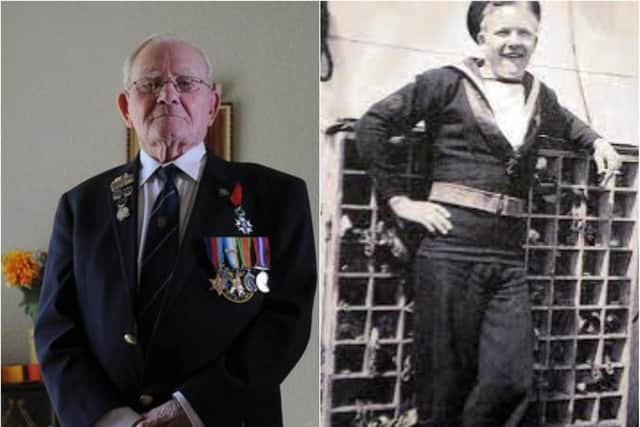"It was fantastic:" Doncaster D-Day veteran, 97, finally sees WW2 memorial on trip to France
and live on Freeview channel 276
Frank Baugh, 97, was among a handful of veterans who travelled across the Channel to visit the British Normandy Memorial ahead of Remembrance Sunday later this month.
The memorial was unveiled via video link in June because of coronavirus restrictions but a small band of veterans, all in their nineties, were able to pay homage in person at a moving service to remember fallen colleagues.
Advertisement
Hide AdAdvertisement
Hide AdThe £30million monument on a ridge above the Normandy beaches is inscribed with the names of 22,442 military personnel from 38 nations who who died on D-Day on June 6, 1944 and in the Battle of Normandy.


Just eight veterans headed to Ver-sur-Mer for the ceremony after Covid rules finally allowed travel to France with Mr Baugh of Wheatley Hills among them.
Royal Navy signalman Frank said of braving the pandemic for the occasion: “I was lucky I stayed alive on D-Day and believe I’ll be lucky again with Covid.”
Great-grandfather Frank’s craft was the first to land on Queen Red Sector of Sword Beach at 7.25am on D-Day.
Advertisement
Hide AdAdvertisement
Hide AdThe boat took a direct hit from German artillery. It managed to land 200 men from the King’s Shropshire Light Infantry but was marooned on the beach for four hours.
“It was hellish,” Frank recalled. “Bullets were ricocheting off the mast. I didn’t dare put my head up.
“The Shropshire lads didn’t need any urging — they ran up the beach like greyhounds. If any man says they weren’t frightened, they must be stupid.”
Frank added: “It was fantastic to finally see the memorial. We’ve waited so long for it.”
Advertisement
Hide AdAdvertisement
Hide AdThe memorial — which took six years to build — is the culmination of years of campaigning by UK veterans.
Commemorating the largest seaborne invasion in history, the 50-acre site’s centrepiece is a stirring bronze D-Day statue of three soldiers charging inland.
Those present included General Lord Dannatt — former head of the Army — and Henry, Viscount Montgomery of Alamein, and D-Day commander Field Marshal Bernard “Monty” Montgomery’s grandson David.
In June around 100 veterans watched the monument being unveiled via a live broadcast from the National Memorial Arboretum in Staffordshire.
Advertisement
Hide AdAdvertisement
Hide AdOn D-Day, some 160,000 Allied troops landed on the beaches, codenamed Omaha, Utah, Juno, Sword and Gold, carried by 7,000 boats. Then the Battle of Normandy raged for almost three months.
In an interview with the Free Press to mark the 75th anniversary of D-Day in 2019, he said: “All hell broke loose.
“The sea was red with blood. I’ll never forget the things I saw that day.”
In the early hours of June 6, orders finally came through and Mr Baugh’s ship, along with 6,000 others, were loaded up with soldiers, weapons and essential supplies ready for the short Channel crossing to Normandy.
Advertisement
Hide AdAdvertisement
Hide Ad“We saw all the ships at sea and realised the extent of it. As we got closer, the lads on board fell silent.”
But the air was full of noise as aircraft swarmed overhead, paving the way for the sea assault.
As daylight broke, the French coast came in sight - and that’s when “all hell broke loose” as Mr Baugh’s craft approached its designated section of Sword beach.
"The shells were going over our heads, you could feel the air rushing past as they flew over. You could feel the tremors as they hit,” he said.
Advertisement
Hide AdAdvertisement
Hide Ad“We were being machine gunned and shelled from all over the place.” One found its target and holed the ship - causing devastating injuries and damage.
“A lot of lads were seriously injured, it was the first time I had seen shrapnel wounds. It was horrific. The sea was red and we could see bodies floating in the water. I had never seen anything like it.”
“We saw men face down, we wanted to help…but of course we couldn’t.”
The ship managed to reach the beach before sinking - but with the troops off and storming up the sands, problems were far from over for the crew. The Germans continued to shell the incoming craft - and there was still the task of patching up the boat so it could return safely back to England.
Advertisement
Hide AdAdvertisement
Hide Ad“We managed to patch the hole up as best we could and got off the beach and made it back.” However, although D-Day was over, that was just the start of scores of missions for Mr Baugh over the coming months, criss-crossing the channel dozens of times to deliver more supplies and troops to the front.
After the boat’s decommissioning in 1946 and his return to Civvy Street, the memories of D-Day were locked away for fifty years.
“We didn’t talk about what we’d seen. Everyone had suffered, everyone had known bombs and death. We just wanted to move on.”
However, in 2010, he made the decision to return to those French beaches once more - and has been a regular at memorial events since.
Advertisement
Hide AdAdvertisement
Hide Ad“Going back is always very emotional. I see the beaches and you see children paddling in the water and it makes me think of when the sea was red with blood, or people sunbathing in front of the armaments that are still there. In my mind I go back to D-Day and the things I saw - they will always be with me and it is important that we never forget them, ” he added.